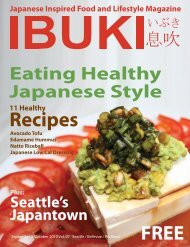FEATuRE sushi EXpLAiNED - IBUKI Magazine
FEATuRE sushi EXpLAiNED - IBUKI Magazine
FEATuRE sushi EXpLAiNED - IBUKI Magazine
Create successful ePaper yourself
Turn your PDF publications into a flip-book with our unique Google optimized e-Paper software.
The key, he says, is delivering fresh, tasty, well-made pieces of <strong>sushi</strong> that<br />
please his customers. That equation for success hasn’t changed since the<br />
days of Edo.<br />
Despite a plethora of fusion restaurants and rolls with all sorts of nontraditional<br />
ingredients, the skill and aesthetic simplicity embodied in<br />
Edomae <strong>sushi</strong> is far from lost. Chefs such as Yuki Goto of Fuji Sushi in the<br />
International District spend day and night mastering the craft. Goto got<br />
his start doing rolls in California, but now he’s doing traditional <strong>sushi</strong> in<br />
Seattle. The difference? “Edomae <strong>sushi</strong> is complete deliciousness, which<br />
the chef enhances,” he says. “Rolls are fun.”<br />
“There’s the warmth of the rice and the coolness or warmth of the<br />
topping – there are many levels at play,” says Nakazawa. “We try to serve it<br />
at the best possible time, so we’d like you to eat it right away.”<br />
Sushi a la Carte served in traditional boat<br />
shaped plate at Shima Sushi in Walingford.<br />
Photo By Kenji nakayama<br />
Chef Tak Sasaki of Shima Sushi (4429 Wallingford Ave N, Seattle)<br />
beautifully arranges <strong>sushi</strong> a la carte on a special boat-shaped<br />
plate.<br />
Sushi culture is filled with arcane trivia. Did you know that the chef and<br />
staff in a Japanese restaurant have code words for numbers? That allows<br />
the chef to yell out the total of a bill without embarrassing (or shocking)<br />
the customer. There are other code words, too, which connoisseurs<br />
can use to show off their knowledge. Call the soy sauce “murasaki” (the<br />
Japanese word for “purple”) and you’ll sound like a pro. Or say “agari” at the<br />
end of your meal and you’ll get a cup of green tea.<br />
But most important to the <strong>sushi</strong> experience is to cut through the<br />
mystery and embrace the cuisine’s essence: fresh, often local food served<br />
with dexterity in a convivial atmosphere. It’s served quickly and should<br />
be consumed quickly. It’s delicious, and it’s healthy. Not much mystery<br />
in that.<br />
On the following pages, we’ll introduce some of the most popular <strong>sushi</strong><br />
toppings, ask local chefs for tips and say farewell to a seafood pioneer.<br />
www.ibukimagazine.com 7





